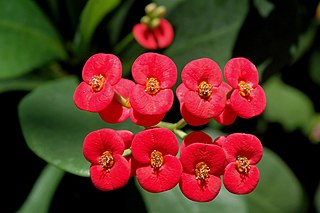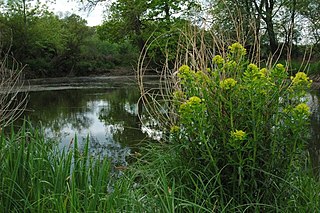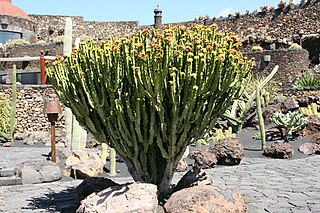
Euphorbia is a large and diverse genus of flowering plants, commonly called spurge, in the family Euphorbiaceae.

The poinsettia is a commercially important flowering plant species of the diverse spurge family Euphorbiaceae. Indigenous to Mexico and Central America, the poinsettia was first described by Europeans in 1834. It is particularly well known for its red and green foliage and is widely used in Christmas floral displays. It derives its common English name from Joel Roberts Poinsett, the first United States minister to Mexico, who is credited with introducing the plant to the US in the 1820s. Poinsettias are shrubs or small trees, with heights of 0.6 to 4 m. Though often stated to be highly toxic, the poinsettia is not dangerous to pets or children. Exposure to the plant, even consumption, most often results in no effect, though it can cause nausea, vomiting, or diarrhea.

Euphorbia virosa, the Gifboom or poison tree, is a plant of the spurge family Euphorbiaceae. It has a short main stem, usually twisted, from which 5–10 cm branches emerge. These leafless branches have 5 to 8 edges. Paired thorns grow in regularly spaced intervals from the edges.

In botany, a bract is a modified or specialized leaf, especially one associated with a reproductive structure such as a flower, inflorescence axis, or cone scale.
Mookgophong, formerly known as Naboomspruit, is a town in the Limpopo province of South Africa. The town is located approximately 42 km north-east of Modimolle and 51 km south-west of Mokopane.

Euphorbia amygdaloides, the wood spurge, is a species of flowering plant in the family Euphorbiaceae, native to woodland locations in Europe, Turkey and the Caucasus. It is a bushy evergreen perennial, growing to a height of 80 cm (31 in), with dark green slightly hairy leaves about 6 cm (2 in) long. The complex green-yellow inflorescence (cyathium), typical of Euphorbia, appears in late spring and early summer.

Euphorbia milii, the crown of thorns, Christ plant, or Christ's thorn, is a species of flowering plant in the spurge family Euphorbiaceae, native to Madagascar. The species name commemorates Baron Milius, once Governor of Réunion, who introduced the species to France in 1821.

Euphorbia peplus, is a species of Euphorbia, native to most of Europe, northern Africa and western Asia, where it typically grows in cultivated arable land, gardens and other disturbed land.

Tinyatoxin is an analog of the neurotoxin resiniferatoxin. It occurs naturally in Euphorbia poissonii.

Euphorbia poissonii, also known as Euphorbia poissoni and, incorrectly, as Euphorbia poisoni, is a highly irritant and toxic succulent member of the large and varied spurge family of plants. It is native to northern Nigeria, where local farmers extract its latex for use as a pesticide. Its powerfully irritant and pain-producing nature mandates use as a fencing plant. It is known to the Berom people of the Jos area as pyùlúp who transplant it to their compounds where it is regarded as protection against witchcraft.

Euphorbiaceae, the spurge family, is a large family of flowering plants. In English, they are also commonly called euphorbias, which is also the name of the type genus of the family. Most spurges, such as Euphorbia paralias, are herbs, but some, especially in the tropics, are shrubs or trees, such as Hevea brasiliensis. Some, such as Euphorbia canariensis, are succulent and resemble cacti because of convergent evolution. This family has a cosmopolitan global distribution. The greatest diversity of species is in the tropics; however, the Euphorbiaceae also have many species in nontropical areas of all continents except Antarctica.

Euphorbia marginata is a small annual in the spurge family.

Euphorbia palustris, the marsh spurge or marsh euphorbia, is a species of flowering plant in the family Euphorbiaceae, native to marshland throughout much of mainland Europe and western Asia. It is an herbaceous perennial growing to 90 cm (35 in) tall and wide, with narrow leaves turning red and yellow in autumn, and persistent, bright acid yellow flower-heads (cyathia), 15 cm (6 in) across, in spring.

Euphorbia hirta is a pantropical weed, originating from the tropical regions of the Americas. It is a hairy herb that grows in open grasslands, roadsides and pathways. It is widely used in traditional herbal medicine across many cultures, particularly for asthma, skin ailments, and hypertension. It is also consumed in herbal tea form as folk medicine for fevers in the Philippines, particularly for dengue fever and malaria.

Euphorbia antiquorum, known as antique spurge and "Euphorbia of the Ancients", is a species of succulent plant in the family Euphorbiaceae. It is widespread throughout peninsular India, but its wild origin is obscure. Escaped or naturalized and widely cultivated in neighbouring regions, such as Burma, China, Bangladesh, India, Indonesia, Iran, Malaysia, Myanmar, Pakistan, Thailand, the Philippines, Sri Lanka, and Vietnam, and in many tropical zones worldwide.

Euphorbia abyssinica, commonly known as the desert candle or candelabra spurge, is a species of plant in the family Euphorbiaceae. E. abyssinica is endemic to Ethiopia, Somalia, Sudan and Eritrea. It was first described in 1791, by the German botanist Johann Friedrich Gmelin. In its native habitat, it can grow up to 10 m (33 ft) tall. The woody stem is used for firewood and as timber in roofing, furniture and other items, and the sap is used in traditional medicine. It is also cultivated as an ornamental house plant.















